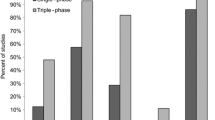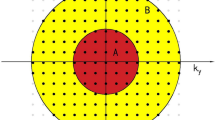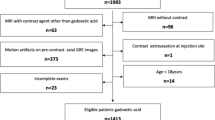Abstract
Objectives
Second shot arterial phase (SSAP) imaging is an additional arterial phase image obtained by re-injecting a small amount of contrast medium after routine dynamic imaging in gadoxetic acid-enhanced liver MRI. We aimed to evaluate the feasibility and additional value of a SSAP image in gadoxetic acid-enhanced liver MRI.
Methods
One hundred seventy-two patients who underwent SSAP imaging after re-injection of 4 mL of contrast material after routine dynamic imaging (original) in gadoxetic acid-enhanced liver MRIs were included. Motion artifacts on arterial phase (AP) images were rated using a 5-point scale and were compared between the original AP images and SSAP images. We evaluated visual detection rates of arterial hypervascularity on the original AP and SSAP images and their subtraction images in patients with hypervascular hepatocellular carcinoma (HCC).
Results
The motion artifact of the SSAP images was significantly lower than that of the original AP images (mean score, 1.76 vs 2.06; p < 0.001). In particular, motion artifacts reduced significantly in the SSAP images of patients with substantial motion artifacts in their original AP images (2.28 vs 3.28; p < 0.001). Among the 30 HCC lesions showing hypervascularity on original AP images, only four (4/30, 13.3%) appeared hyperintense on SSAP images. However, subtraction images of SSAP clearly demonstrated arterial hypervascularity in all HCCs.
Conclusion
SSAP images showed significantly fewer motion artifacts than the original AP images. Subtraction images of SSAP maintained the detectability of arterial hypervascularity, although SSAP images showed poor visual detection of arterial hypervascularity of HCC.
Key Points
• Arterial phase images obtained after a second injection of a small amount of contrast medium (second shot arterial phase [SSAP]) improved motion artifacts compared to the original AP images.
• The motion artifacts improved significantly in the SSAP images of patients with substantial motion artifacts in their original AP images.
• Subtraction images of SSAP demonstrated the arterial hypervascularity characteristic of HCC at a level comparable to that of the original AP image.




Similar content being viewed by others
Abbreviations
- AP:
-
Arterial phase
- CAIPIRINHA:
-
Controlled aliasing in parallel maging results in higher acceleration
- HBP:
-
Hepatobiliary phase
- HCC:
-
Hepatocellular carcinoma
- LLC:
-
Lesion-to-liver contrast
- MRI:
-
Magnetic resonance imaging
- SI:
-
Signal intensity
- SNR:
-
Signal-to-noise ratio
- SSAP:
-
Second shot arterial phase
References
Sun HY, Lee JM, Shin CI et al (2010) Gadoxetic acid-enhanced magnetic resonance imaging for differentiating small hepatocellular carcinomas (< or =2 cm in diameter) from arterial enhancing pseudolesions: special emphasis on hepatobiliary phase imaging. Invest Radiol 45:96–103
Kim YK, Lee MW, Lee WJ et al (2012) Diagnostic accuracy and sensitivity of diffusion-weighted and of gadoxetic acid-enhanced 3-T MR imaging alone or in combination in the detection of small liver metastasis (≤ 1.5 cm in diameter). Invest Radiol 47:159–166
Park YS, Lee CH, Kim JW, Shin S, Park CM (2016) Differentiation of hepatocellular carcinoma from its various mimickers in liver magnetic resonance imaging: what are the tips when using hepatocyte-specific agents? World J Gastroenterol 22:284–299
Elsayes KM, Hooker JC, Agrons MM et al (2017) 2017 version of LI-RADS for CT and MR imaging: an update. Radiographics 37:1994–2017
Huh J, Kim SY, Yeh BM et al (2015) Troubleshooting arterial-phase MR images of gadoxetate disodium-enhanced liver. Korean J Radiol 16:1207–1215
Davenport MS, Caoili EM, Kaza RK, Hussain HK (2014a) Matched within-patient cohort study of transient arterial phase respiratory motion-related artifact in MR imaging of the liver: gadoxetate disodium versus gadobenate dimeglumine. Radiology 272:123–131
Pietryga JA, Burke LM, Marin D, Jaffe TA, Bashir MR (2014) Respiratory motion artifact affecting hepatic arterial phase imaging with gadoxetate disodium: examination recovery with a multiple arterial phase acquisition. Radiology 271:426–434
Park YS, Lee CH, Kim IS et al (2014) Usefulness of controlled aliasing in parallel imaging results in higher acceleration in gadoxetic acid-enhanced liver magnetic resonance imaging to clarify the hepatic arterial phase. Invest Radiol 49:183–188
Yoo JL, Lee CH, Park YS et al (2016) The short breath-hold technique, controlled aliasing in parallel imaging results in higher acceleration, can be the first step to overcoming a degraded hepatic arterial phase in liver magnetic resonance imaging: a prospective randomized control study. Invest Radiol 51:440–446
Park YS, Lee CH, Kim JW, Lee YS, Paek M, Kim KA (2017) Application of high-speed T1 sequences for high-quality hepatic arterial phase magnetic resonance imaging: intraindividual comparison of single and multiple arterial phases. Invest Radiol 52:605–511
Min JH, Kim YK, Kang TW et al (2018) Artifacts during the arterial phase of gadoxetate disodium-enhanced MRI: multiple arterial phases using view-sharing from two different vendors versus single arterial phase imaging. Eur Radiol 28:3335–3346
Yoon JH, Lee JM, Yu MH et al (2018) Evaluation of transient motion during gadoxetic acid-enhanced multiphasic liver magnetic resonance imaging using free-breathing golden-angle radial sparse parallel magnetic resonance imaging. Invest Radiol 53:52–61
Kim YK, Lin WC, Sung K et al (2017) Reducing artifacts during arterial phase of gadoxetate disodium-enhanced MR imaging: dilution method versus reduced injection rate. Radiology 283:429–437
Polanec SH, Bickel H, Baltzer PAT et al (2017) Respiratory motion artifacts during arterial phase imaging with gadoxetic acid: can the injection protocol minimize this drawback? J Magn Reson Imaging 46:1107–1114
Korean Society of Abdominal Radiology (2017) Diagnosis of hepatocellular carcinoma with gadoxetic acid-enhanced MRI: 2016 consensus recommendations of the Korean Society of Abdominal Radiology. Korean J Radiol 18:427–443
Bashir MR, Castelli P, Davenport MS et al (2015) Respiratory motion artifact affecting hepatic arterial phase MR imaging with gadoxetate disodium is more common in patients with a prior episode of arterial phase motion associated with gadoxetate disodium. Radiology 274:141–148
Davenport MS, Bashir MR, Pietryga JA, Weber JT, Khalatbari S, Hussain HK (2014) Dose-toxicity relationship of gadoxetate disodium and transient severe respiratory motion artifact. AJR Am J Roentgenol 203:796–802
Tanimoto A, Higuchi N, Ueno A (2012) Reduction of ringing artifacts in the arterial phase of gadoxetic acid-enhanced dynamic MR imaging. Magn Reson Med Sci 11:91–97
Motosugi U, Ichikawa T, Sano K et al (2011) Double-dose gadoxetic acid-enhanced magnetic resonance imaging in patients with chronic liver disease. Invest Radiol 46:141–145
Choi SH, Kim SY, Lee SS et al (2017) Subtraction images of gadoxetic acid-enhanced MRI: effect on the diagnostic performance for focal hepatic lesions in patients at risk for hepatocellular carcinoma. AJR Am J Roentgenol 209:584–591
An C, Park MS, Kim D et al (2013) Added value of subtraction imaging in detecting arterial enhancement in small (<3 cm) hepatic nodules on dynamic contrast-enhanced MRI in patients at high risk of hepatocellular carcinoma. Eur Radiol 23:924–930
Lauenstein T, Ramirez-Garrido F, Kim YH et al (2015) Nephrogenic systemic fibrosis risk after liver magnetic resonance imaging with gadoxetate disodium in patients with moderate to severe renal impairment: results of a prospective, open-label, multicenter study. Invest Radiol 50:416–422
Funding
This study has received funding by Korea University Grant (K1609801) and grant from the Department of Radiology, Korea University (KUMCRG).
Author information
Authors and Affiliations
Corresponding author
Ethics declarations
Guarantor
The scientific guarantor of this publication is Dr. Chang Hee Lee.
Conflict of interest
The authors declare that they have no competing interests.
Statistics and biometry
No complex statistical methods were necessary for this paper.
Informed consent
Written informed consent was waived by the Institutional Review Board.
Ethical approval
Institutional Review Board approval was obtained.
Methodology
• Retrospective
• Observational
• Performed at one institution
Rights and permissions
About this article
Cite this article
Park, Y.S., Lee, J., Kim, J.W. et al. Second shot arterial phase to overcome degraded hepatic arterial phase in liver MR imaging. Eur Radiol 29, 2821–2829 (2019). https://doi.org/10.1007/s00330-018-5897-x
Received:
Revised:
Accepted:
Published:
Issue Date:
DOI: https://doi.org/10.1007/s00330-018-5897-x




